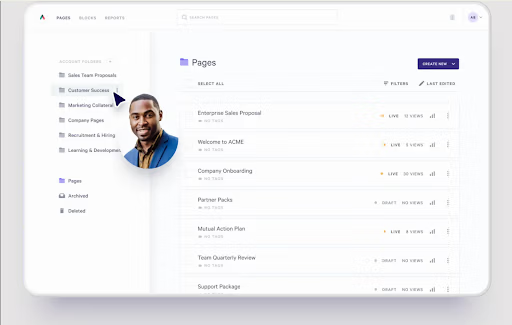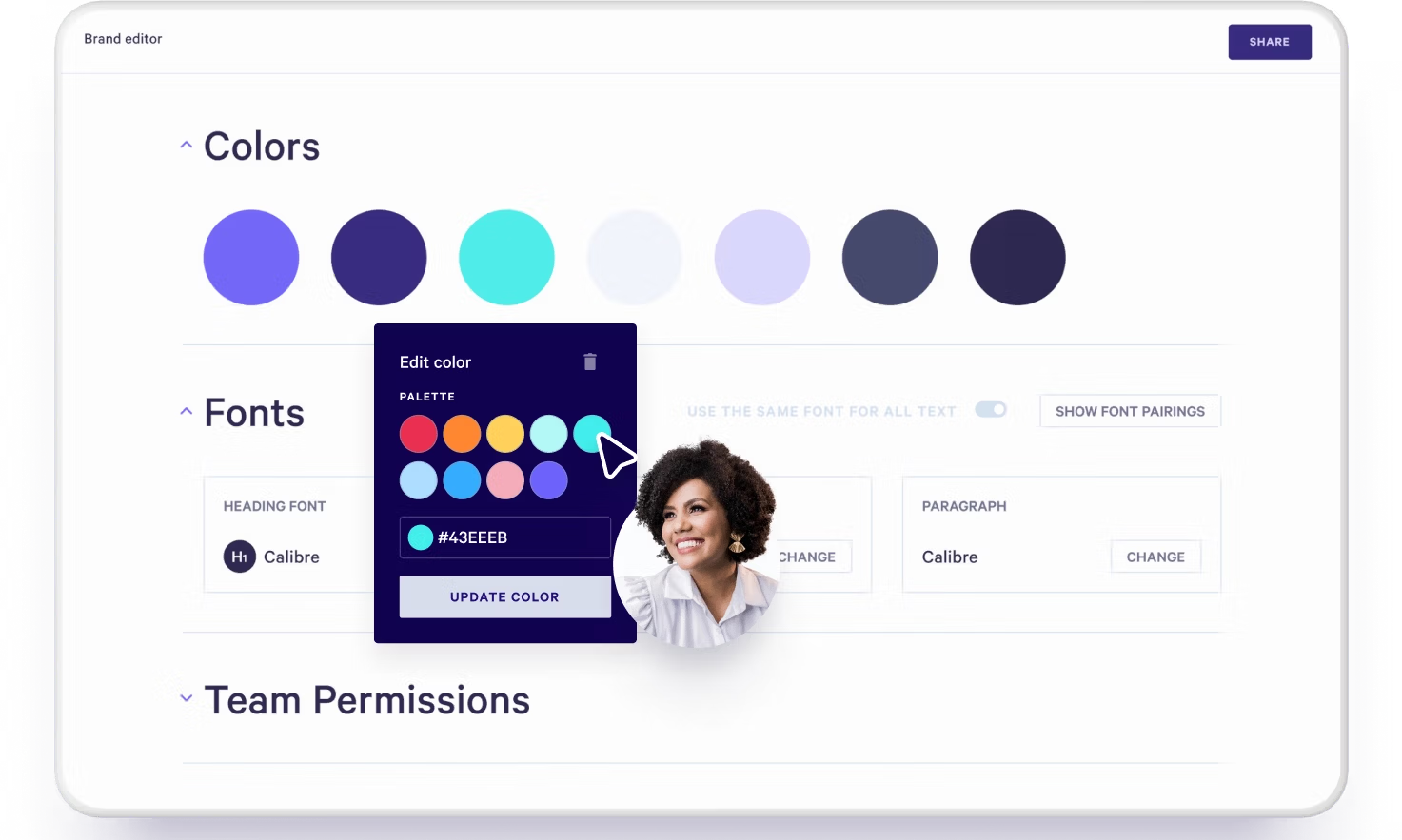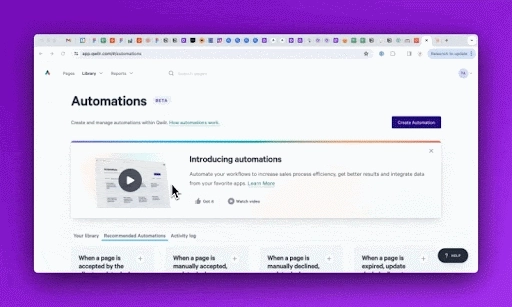Hopefully, you enjoy being a sales leader—you live for the thrill of closed deals and smashed quotas. But lately, something's off. Those promising leads? They're slipping through your fingers at an alarming rate and even though your team is out there, giving it their all, objections are piling up, and your team's struggling to make an impact.
When every deal counts, and adapt or perish is the mantra, savvy sales leaders leverage powerful sales enablement strategies to turn market challenges into winning opportunities.
We spoke to industry experts to uncover the top sales enablement best practices that will help you arm your team to tackle objections head-on, navigate complex buying journeys, increase forecasted deals and revenue, and ace the sales battlefield.
Key Takeaways
- Effective sales enablement is an ongoing process that empowers teams with the right tools, knowledge, and resources, leading to increased win rates, larger deals, and shorter sales cycles.
- Success hinges on aligning sales and marketing, setting SMART goals, building a robust tech stack, and creating accessible, personalized content for sales teams.
- Identifying ideal customer profiles, involving stakeholders early, and leveraging data analytics help create targeted, effective sales strategies and drive better results.
- Implementing automation, fostering continuous learning, and simplifying content access not only boost sales performance but also enhance customer relationships and overall business growth.
How to implement a successful sales enablement system
To implement a sales enablement system that moves the needle in the right direction, it’s important to know that it's not just a one-time training session, but an ongoing journey that empowers your reps with the know-how, skills, and resources they need to truly connect with your buyers.
The key insight, however, is this: before diving headfirst into sales enablement, astute sales leaders recognize the need to lay the groundwork where sales enablement can take root and drive significant, lasting improvements in your team's performance.
The result? A range of positive outcomes which include increased win rates and deal sizes, shorter sales cycles, improved rep productivity and sales efficiency, and ultimately customer satisfaction, retention, and lead generation.
11 trusty sales enablement practices
The right sales enablement practices don't just tick boxes; they fundamentally transform how your team operates and engages with prospects.
We'll show you why these practices matter and how they can give your sales team a real edge in today's tough market.
#1 Set SMART sales enablement goals
Setting Specific, Measurable, Achievable, Relevant, and Time-Bound (SMART ) goals is the cornerstone of effective sales enablement and is like giving your sales team a map and compass. SMART goals transform abstract sales enablement concepts into actionable strategies, aligning your team's efforts with measurable business outcomes.
It's not just about saying "let's do better" – it's about picking specific targets that make sense for your team.
But how do you go about setting these SMART goals?
Let's break it down:
- Specific: Pinpoint exactly what you want to achieve
- Measurable: Ensure you can track progress with numbers
- Achievable: Set ambitious but realistic targets
- Relevant: Align with broader business objectives
- Time-bound: Set a clear deadline
For example, instead of "increase sales productivity," a SMART goal might be:
"Increase the average deal size by 15% within the next quarter by implementing a new value proposition training program for the entire sales team."
This goal is specific (focused on deal size), measurable (15% increase), achievable (with targeted training), relevant (directly impacts revenue), and time-bound (next quarter).
Ultimately, every company is different, so your goals should be too.
For one company, this might mean doubling close rate in six months, while another might focus on reducing onboarding time for new reps from three months to six weeks. The key is tailoring these goals to your team's unique challenges.
#2 Build alignment between sales and marketing
We've all heard the grumbles when it comes to sales and marketing alignment in organizations: marketing says sales aren't using their materials, while sales complain the leads are no good. This back-and-forth can really gum up the work.
But imagine if it wasn’t the case? Imagine salespeople armed with spot-on content that speaks directly to customer pain points. Or marketing folks crafting campaigns based on real feedback from the frontlines i.e. your sales teams.
Erman Ergun, Head of Sales Enablement at Jotform, believes that when it comes to sales enablement, “the sales and marketing team should work together like peanut butter and jelly.”
It’s important to involve people that live and breathe sales within a business from junior to senior employees.
Colin Hugo, Sales Lead, reiterates:
“Too often sales strategies, enablement, and content are created without input from those who have daily touch points with clients. This results in content that doesn't resonate with the sales team which ultimately sets the whole process up for failure. You need to have instant buy-in, if the content sounds like fluff it will fall on deaf ears.”
This teamwork can mean shorter sales cycles, happier customers, and a lot less wasted effort.
Getting there isn't always easy, but it's worth it. Start with regular sit-downs where both teams share wins and worries, or try having marketers shadow sales calls to really get what customers are asking.
You may even try the Jotform approach of “conducting bi-weekly meetings in order to brainstorm and share the latest updates from both ends.”, as Ergun explains.

Get sales and marketing on the same page by creating a single destination for sales content. With Qwilr it’s easy to create a marketing-approved library of assets reps can pull from to create personalized content, fast.
#3 Work on building a sales stack that delivers
A well-chosen sales tech stack, especially one that puts sales enablement front and center is like giving your crew a high-powered impact wrench – suddenly, everything moves faster and smoother allowing you to turn these challenges into distant memories.
But here’s the thing—it's not just about having fancy sales enablement tools; it's about having the right ones that work together seamlessly. A few ways in a tech stack with a focus on sales enablement can help:
- Building product knowledge gaps: When your new reps struggle to articulate key features, it's not just embarrassing—it costs you deals. A robust knowledge base can turn those awkward silences into confident pitches.Think of what this could be for your team? Case studies, sales battlecards or something else?
- Improve inconsistent messaging: If your team isn't aligned on pricing or features, you risk confusing customers and losing credibility. A unified content system ensures everyone's speaking the same language.
- Shorten lengthy onboarding processes: An effective training platform can significantly reduce ramp-up time, getting your new talent productive faster.
- Provide deep performance insights: Understanding why some reps consistently outperform others shouldn't be guesswork. Good analytics tools can uncover the tactics of your top performers, helping you replicate their success across the team.
So which sales enablement tools should your sales team run with?
Ergun unbundles a few for us. He states:
“For sales enablement, a mix of the right tools can really elevate your game. CRM systems, sales enablement platforms, and analytics tools are your best friends for keeping everything organized and efficient.”
According to Ergun, “a solid CRM like HubSpot or Salesforce is crucial” alongside content management tools, such as SharePoint, and good communication tools.
At Qwilr, we love sales intelligence tools such as Gong and, of course, Qwilr!
Guy Hall, Qwilr’s very own Product Marketing Manager, says:
“Qwilr is a fantastic tool for sales enablement. It allows you to effortlessly create compelling collateral that cuts through the noise with its dynamic and interactive elements. The fact that you are able to view analytics, and assess which aspects of your content people are engaging with is invaluable when it comes to future iteration.”
#4 Build top-notch training programs
Your training program is the difference between a sales team that just goes through the motions and one that consistently crushes targets. A recent Qwilr report found that sales training is crucial for both the company as well as the sales reps. For companies, investment in sales training yields significant ROI, with an average of 353%.
For sales reps, sales training is more than just product knowledge—it's about creating confident, adaptable reps who can navigate today's complex sales landscape. Good training bridges skill gaps, boosts employee satisfaction and ensures consistency across your team. Needless to say, 47% of AEs have left a sales job due to a lack of training or a poor onboarding experience
But does it need to be boring PowerPoint presentations and day-long seminars? Not really. Below are a few ways modern ways in which sales leaders can ensure that their team is up to date
- Schedule regular "market pulse" briefings
- Implement a peer-to-peer knowledge-sharing program
- Set up alerts for industry news and competitor updates
- Create a digital library of current product and market information
- Encourage participation in relevant webinars and online courses
- Organize monthly "what's new" sessions with product teams
- Establish a mentorship program pairing veterans with newcomers
- Use gamification to make ongoing learning engaging
- Conduct periodic skills assessments to identify knowledge gaps
- Invite customers to share their evolving needs and challenges
Ultimately, it's an investment that pays off in spades - in better performance, happier customers, and a more engaged sales force.
#5 Simplify access to content
If your reps are spending more time hunting for materials than actually selling, you've got a problem. Simplifying content access isn't just about convenience—it's about empowering your team to respond quickly to customer needs and close deals faster.
To make this happen, consider setting up a centralized content repository that's searchable and well-organized. Tag content by buyer persona, sales cycle stage, and product line to make it easy to find. Implement a system that suggests relevant content based on the deal context. Regular content audits can help weed out outdated materials. Don't forget mobile access—your reps should be able to pull up what they need on the go. And here's a pro tip: involve your top performers in organizing and curating content.
They know what works in the field. By streamlining content access, you're not just saving time—you're boosting your team's confidence and effectiveness in every customer interaction.
#6 Identify your sales ICPs early on
When it comes to sales, nailing down your ideal customer profile (ICP) is the difference between casting a wide net and using a precise, laser-focused approach. When you've got a clear ICP, your sales enablement efforts become supercharged—your content resonates better, your pitches hit the mark, and your team's time is spent on prospects most likely to convert.
Imagine this: instead of chasing every lead, your reps are engaging with decision-makers who actually need your solution and have the budget for it. Your marketing team creates content that speaks directly to these ideal customers' pain points. Your product demos are tailored to showcase features that matter most to your ICP. The result? Higher conversion rates, shorter sales cycles, and bigger deals.
According to a study by Hubspot, companies that align their sales efforts around a well-defined ICP see a 68% higher win rate compared to those that don't. That's not just a small boost—it's a game-changing difference.
By focusing your sales enablement strategy around your ICP, you're not just working smarter; you're setting your team up for remarkable success.
#7 Offer personalized content
Imagine you're selling a project management platform. Instead of using a one-size-fits-all demo, you create custom presentations for different industries. For a software development company, you highlight your tool's integration with GitHub and features for managing sprints. For a marketing agency, you focus on campaign planning features and client reporting dashboards.
When you tailor your materials to address specific customer needs, industries, and use cases, you're showing prospects that you truly understand their unique challenges.
The impact of this approach is clear: A McKinsey report found that 71% of consumers expect companies to deliver personalized interactions. And 76% get frustrated and walk away when this doesn’t happen.
But is it worth the effort? A report by Seismic found that the power of personalized content is on the rise and buyer engagement increased by 57% when companies used tailored content to generate higher conversion—we surely have our answer!

Use our powerful editor, easy-to-use templates, Unsplash image library, brand controls, and modular building blocks to create polished sales materials.
#8 Involve stakeholders from the onset
By engaging key decision-makers, end-users, and subject matter experts early, organizations can develop more effective and tailored sales strategies.
Instead of thinking in isolation this approach can help you tap into the specific expertise of each department, allowing you to create more effective, well-rounded enablement resources that directly address customer needs and drive results.
Product managers, for example, can provide deep technical insights and roadmap visibility, enabling sales reps to speak authoritatively about features and future developments. Marketing can ensure brand messaging consistency and share valuable customer persona research. Customer success can contribute real-world implementation stories and common problem-solving scenarios!
Our product marketing guru, Guy Hall, believes that communication and collaboration are crucial when it comes to a successful sales enablement strategy. He explains:
“You need to ensure that everyone is on the same page in terms of objectives and desired outcomes, and involving all key stakeholders early in the process to align on objectives and outcomes is a good way to think about it.”
#9 Automate to scale the process
Think about it: instead of your top performers getting bogged down in paperwork, they're out there having meaningful conversations with prospects. For example, automated lead scoring can instantly prioritize hot leads, ensuring your team always knows who to call first. A robust proposal management software, on the other hand, can streamline content creation, customization, and delivery, allowing your sales team to quickly produce tailored, professional proposals that align with the overall strategic goals and customer needs.
In a nutshell, automation can help sales leaders boost productivity and consistency across the board and help your team drive significant revenue growth and client satisfaction—it’s a win-win.

With Qwilr, sales reps can generate sales quotes, pitch decks, digital sales rooms, and more from a CRM within minutes of speaking with a buyer. Qwilr integrates with all the leading CRM, sales, and accounting software.
#10 Make use of data and analytics
Knowing your numbers helps you sell better. By harnessing the power of data you can make informed decisions, identify trends, and optimize strategies in real-time for your sales team.
That being said, data isn't just about looking back - it's about moving forward strategically. Consider your sales team might use customer behavior data to anticipate needs. If your analytics show that clients who purchase Product A typically need Product B within six months, your reps can proactively reach out at the right time, positioning themselves as trusted advisors rather than just salespeople.
Let's talk about the human side too. Data can help personalize your coaching. If your analytics show that Rep X excels at initial outreach but struggles with follow-ups, you can tailor your mentoring to boost those specific skills.
Remember, the goal isn't to drown in data but to use it as a tool to make smarter decisions.
#11 Practice continuous improvement through learning
One of the most low-hanging fruit, yet a missed opportunity for most businesses is continuous training for their sales team. By offering ongoing training and development opportunities, you're not just boosting sales performance – you're investing in your people's careers.
This approach can work wonders for keeping your team engaged and motivated. Think skills workshops, online courses, or even mentorship programs. Companies that prioritize learning see some impressive results: higher win rates on deals, better employee retention, and more satisfied customers.
It’s time to make your sales enablement practices work!
Great sales enablement is like giving your sales team superpowers. It's about creating an environment where they can shine, armed with the right tools, know-how, and support. Think of it as building a sales force that's always one step ahead, ready to tackle sales objections like a pro!
The best part? When you nail sales enablement, you're not just boosting numbers. You're creating happier customers, more satisfied employees, and a business that's built to grow. It's not a quick fix or a one-time thing – it's more like tending a garden. Keep at it, and you'll watch your sales team (and your business) flourish.
And if you are looking for a central place for your sales team to discover content and have access to up-to-date and relevant materials to present to potential clients then look no further than Qwilr. See how we can level up your sales enablement strategy!
About the author

Marissa Taffer|Founder & President of M. Taffer Consulting
Marissa Taffer is the Founder & President of M. Taffer Consulting. She brings over 15 years of sales and marketing experience across various industries to a broad range of clients.


